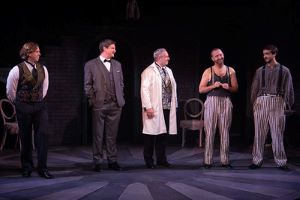The Burning Coal Theatre Company is closing out their 2008-09 season with 1960, a project five years in the making, a labor of love, and one quite personal to troupe members and audiences alike. This presentation also closes out the first year in their fabulous new home officially called the Meymandi Theatre at the Murphey School, only blocks way from Dr. Meymandi’s other named venue that serves as the home of the North Carolina Symphony. However, the recently renovated Murphey School on Polk Street is much more than just a building – in a way it is the star of the show and the audience is sitting in the actual space where great historical events took place.
In 1954, the United States Supreme Court, in the landmark case Brown v. Board of Education, declared that the accepted doctrine of “separate but equal” for schools is inherently unequal and ordered all school districts to formulate plans to integrate their schools “with all deliberate speed.” 1960 is the story of one school district’s response to this directive plus the nearly two centuries of race relations within education preceding 1960. While this play deals with Raleigh, North Carolina and it is a personal story for not only the audience but many of the actors, the events depicted can apply to thousands of communities in the United States during the 1950s, 60s, 70s and, sadly, even beyond.
1960 was written by Ian Finley but also lists “…and members of Burning Coal” as contributors. It is based on interviews with community members who either were involved with these events or simply those who were willing to talk about their memories. Although the play begins with a walk down memory lane to those carefree all American, squeaky clean 1950s, we are soon transported back to colonial times in North Carolina with brief vignettes concerning higher education for African-Americans up though the turmoil of the 1950s, where most of the action takes place.
The Meymandi Theatre is about a thirty-foot square space surrounded by the audience on three sides, plus a small balcony. This in-your-face type theater usually presents plays with small casts and minimal action so it was quite astounding to watch fifteen actors and many set changes take place with such fluidity. Director Jerome Davis and all the staff were nearly miraculous in their use of space and creating myriad inventive ways to sustain interest in a very “talky” play. There was a projector in one corner of the space that was used to project archival images of the time, including that WRAL-TV commentator and Rush Limbaugh precursor, Jesse Helms. David Coulter gave a wonderfully biting portrayal (actually, he was just reading Helms’s own words) and reminded us all of the banality of evil.
In developing this play, it could have easily spiraled into a preachy, boring, Masterpiece Theater type history lesson. Instead, it was quite funny, had some great doo-wop numbers from the 50s and other music, and generally kept the audience engaged, entertained and, most of all, appreciative of the struggles that went on in our backyard in our lifetime. It could, however, use some tightening up in the second half as some scenes became repetitive and superfluous.
The central event, and the reason for the title 1960, is that year the Raleigh school board first agreed to allow an African-American child to enroll in a white school. That decision was made in the very room – previously an auditorium – where we were sitting. William Campbell (later to become mayor of Atlanta) entered the second grade of the Murphey School only because the school officials thought that would be the “safest” thing to do because of his age. Prior to that Elwyna Holt failed after a five-year struggle to get her child into the white Broughton High three blocks away instead of him traveling an hour each way to Ligon High. The scene with Mrs. Holt and a school administrator was one of the most compelling as you became emotionally aligned with the dignified Mrs. Holt’s frustration with ignorant and petty bureaucrats who control much of our lives.
Even with the subject matter and the creative direction and staging, this could still have fallen flat were it not for the all-around superb acting. This was a diverse cast in age, race, sex and professional experience but they all played their parts (most had several characters to portray) with great conviction and skill. This is a mixture of actual transcripts and newly scripted conversations and some familiar names in North Carolina politics come off better than others. Most notably, they saved the highest praise at the very end for Governor Terry Sanford who sent his own children to the newly integrated Murphey School.
As the narrator said throughout the program, 1960 was not a beginning or an end but merely a door we are passing through. We should not feel smug or superior watching this in 2009 – there is still a great deal of inequality and ignorance in our midst.
For ticket prices and remaining show times, see our calendar.











